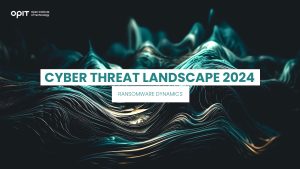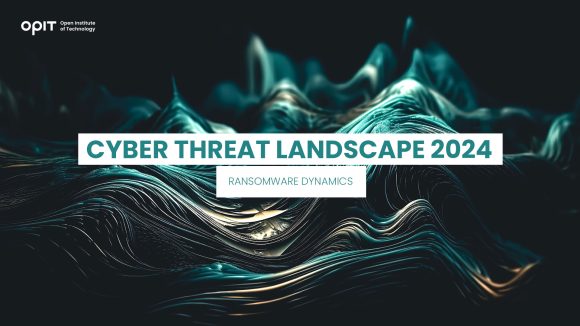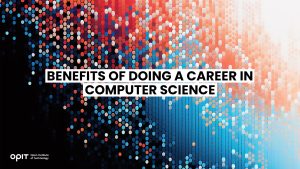

Data is a company’s most valuable asset. So, doing everything in your power to protect that asset is a given. But what if the threat you’re guarding your data against is known to cripple operations, tarnish reputations, and drain finances? And even worse, what if that threat is only getting more dangerous, thanks to a little thing called artificial intelligence (AI)?
Unfortunately, for many businesses, there’s nothing “what if” about this scenario. As many as 72% of businesses worldwide have experienced a ransomware attack at some point and know just how devastating the aftermath can be.
That’s why we tapped two cybersecurity experts to share their insights on ransomware, its evolution, and how businesses can protect themselves. Read on to hear what Tom Vazdar, the chair of the Enterprise Cybersecurity Master’s program at the Open Institute of Technology (OPIT), and Venicia Solomons, a seasoned cybersecurity architect, have to say on this topic in their “Cyber Threat Landscape 2024: Navigating New Risks” master class.
Ransomware: The Basics
Ransomware is nothing new. However, there are always new business owners who (luckily) haven’t encountered it yet. So, let’s cover the basics first.
Ransomware is a natural product of phishing, a human-centric cyber threat that relies on social engineering to deceive individuals into providing sensitive information or downloading malicious attachments. The latter is what ultimately triggers a ransomware infection. Tom describes the process like this:
You click on a malicious link.
Your device downloads the malware.
Your system is now infected, and somebody else is essentially in charge.
They encrypt your data and demand you pay ransom for the encryption key to get it back.
As mentioned, dealing with ransomware attacks and cyber criminals has become a daily reality for companies worldwide. What certainly doesn’t help companies is the fact that ransomware is now also offered as a service.
Ransomware as a Service
Just a few short years ago, cybercriminals needed sophisticated technical skills and tools to develop and deploy ransomware. Now, all they need is access to the dark web.
As Tom explains it, numerous cyber criminals on the dark web offer ransomware as a service, a malicious adaptation of the software as a service (SaaS) business model. So, you essentially pay them to deploy their ransomware on your behalf.
The most famous, or should we say infamous, among these threats is the LockBit model, which has wreaked havoc on thousands of companies worldwide. The issue is that LockBit ransomware attacks vary in tactics, techniques, and procedures. In other words, an organization must be prepared for virtually anything.
How Has AI Affected Ransomware?
Ransomware is dangerous on its own. But throw artificial intelligence into the mix, and you’ve got a massive threat on your hands.
AI has undoubtedly revolutionized the cybersecurity industry, for better or for worse. The “worse” part is that AI is making cyber threats smarter. Unfortunately, for organizations, this particularly applies to ransomware. According to a 2024 report by the U.K.’s top intelligence agency, ransomware stands to gain the most from AI.
How so?
Well, AI has the potential to create malware that circumvents current cybersecurity detection measures. After all, AI is trained using data. Give it malware data to analyze, and it will learn how to evade detection by traditional cybersecurity tools.
AI will also likely generate a surge of new cybercriminals as the barrier to entering into cybercrime decreases with AI-powered tools.
Of course, the more capable and experienced attackers will also benefit from AI. They will use it to identify system vulnerabilities, bypass security defenses, and craft more precise social engineering attacks.
How to Prevent Ransomware Attacks
Given how quickly ransomware is evolving, preventing attacks requires a multi-faceted approach that combines technology, education, and proactive measures. Tom and Venicia break down this approach.
1. Keep Your Systems Updated
When it comes to anything cybersecurity-related, this is the first crucial step. Keep all your systems and programs updated and patched if you want to stand any chance of protecting against known vulnerabilities.
Tom says that there’s a new vulnerability “basically each week,” so having a process in place to update regularly and patch systems is essential.
Venicia adds that something as simple as a basic software update can go a long way toward protecting your data from ransomware. This update will limit its ability to spread through your network, thus reducing the impact of the attack.
2. Invest in Quality Training
Having the most advanced protection systems in place will do you no good if you don’t have well-trained employees.
These employees must learn to recognize potential cyberattacks that could introduce malware into your organization’s system (e.g., phishing emails). Of course, the next step is to respond effectively to the attack. Though each organization has its own set of rules in place, the proper response typically involves disconnecting from the network and contacting IT support.
3. Implement Defensive Systems
Humans are undoubtedly the first line of defense against cyber threats. However, they can’t do it alone. That’s why implementing advanced Endpoint Detection and Response (EDR) solutions is crucial. Tom explains that these systems will help you identify and, more importantly, mitigate a threat on time.
However, he also adds that you must restrict user permissions within the system. This way, even if a single component is compromised, the ransomware won’t take down the entire network.
4. Implement Network Segmentation
As you can see, a huge part of mitigating ransomware attacks is ensuring they don’t affect the entire network. That’s where network segmentation can also help.
As Tom explains, with network segmentation, the malicious actor in control of your network won’t be able to do “lateral movements.” In other words, even if they do manage to penetrate your network, they won’t be able to spread within it.
So, network segmentation is a critical part of the multi-layer approach every organization should adopt when it comes to cybersecurity.
5. Collaborate With Others
Remember – you aren’t the only one experiencing cyberattacks. In Venicia’s words, “ransomware has a global impact.”
That’s why organizations in the private sector are constantly encouraged to “talk to each other,” as Tom puts it. Of course, there’s always the issue of confidentiality, but Tom explains that this, too, can be resolved with a “closed circle of trust.”
Also, organizations in the private and public sectors are encouraged to share relevant information with institutions such as the Financial Services Information Sharing and Analysis Center (FS-ISAC).
In Europe, there’s also something called The No More Ransom Project. This Europol initiative has existed for years, hosting decryption keys for different types of ransomware. It has helped numerous individuals and organizations decrypt their systems and avoid paying the ransom.
Of course, this won’t always be possible, as the attackers typically keep changing the encryption keys. However, anything that helps organizations avoid paying the ransom is worth trying.
Why?
Because paying the ransom often won’t solve any problems.
As Tom explains it, you’re dealing with criminals, after all. So, they will often double the ransom after you pay the initial amount, having realized that you have the money. Or, they’ll simply take the money and run without giving you the decryption keys.
So, ongoing threat intelligence sharing should be among the top priorities for an organization, as it allows them to evade the last-resort scenario of paying the ransom.
6. Invest in Backups and Disaster Recovery
According to Venicia, backups and disaster recovery have a massive role to play in combating ransomware. She says that the primary reason organizations choose to pay the ransom is because they don’t have any backups in place. In other words, they don’t have an alternative way to get their data back.
That’s precisely what Tom has experienced working with many small and medium-sized businesses.
He says that these businesses usually don’t have disaster recovery procedures and data backups because they find them to be too expensive. Other times, they’ll say they didn’t have the time to deal with these measures. But whatever the excuse may be, one thing’s for sure – having no backups leaves you vulnerable to losing your data permanently in a ransomware attack.
According to Tom and Venicia, here’s what an ideal proactive approach to cybersecurity would look like.
Step No. 1 – Have regularly scheduled backups and ensure they’re stored in different environments, including offline ones. Tom suggests the 3-2-1 data backup strategy – have three copies of your data on two different mediums (e.g., hard drives and DVDs) with one copy off-site (a different physical location).
Step No. 2 – Regularly test your backups to see whether they’re able to handle different scenarios.
Step No. 3 – Implement a disaster recovery plan that outlines the steps for different types of incidents. Of course, these incidents shouldn’t only cover ransomware. Earthquakes, floods, and even meteor strikes should be considered in your plan. The last part might seem silly to you. In fact, it also sounded silly to Tom and his colleagues. That is, at least, until a meteor struck Russia in 2013. So, you never know!
The Importance of Cybersecurity Specialists
Most of the strategies for combating ransomware require one thing – a skilled cybersecurity specialist to execute them. This is also what most companies lack, which is why they easily fall victim to cyberattacks.
That’s why programs like the Enterprise Cybersecurity Master’s program at OPIT are essential for the future of cybersecurity. This program helps train the next generation of cybersecurity professionals to defend organizations against the so-called “Ransomware Armageddon” and any other cyber threat that might emerge.
Related posts

Life is unpredictable. While many of us have specific hopes and expectations of how our futures will turn out, things don’t always go as expected. There are many variables and unexpected incidents that can interfere and force you to alter your plans, and this is particularly true when it comes to education.
For instance, you might have had plans to study a specific subject, but had to deviate from those plans due to unforeseen circumstances. Or you may have had to enter the workforce in an occupation different from the one you sought in an effort to earn an income, a move that may not provide you with the time or opportunity to achieve your desired educational aims.
In short, every individual’s career pathway is different, and very few go exactly as we expect from the outset. Fortunately, even if you experience a few false starts or sudden twists in your pathway, there are always options available to help you get back on track.
The Unpredictable Nature of Education
In theory, the educational process seems simple. You select a course of study that interests you from the vast array of subjects and prospective professions, select the appropriate classes, acquire the knowledge and skills you need to succeed, and then embark on your profession.
In reality, however, as many people know from firsthand experience, the road to education is often far from straightforward. Here are just some of the many challenges that can take your educational path in a completely different direction:
- Life’s Curveballs: As touched on in the introduction, life is impossible to predict. Financial hardships, health issues, and family emergencies are just some of the unfortunate occurrences that might derail even the most perfectly planned educational regime.
- Changing Interests: People’s desires and preferences don’t necessarily stay the same throughout their entire lives. As you grow, learn, and have new experiences, your interests may change, and so, too, may your educational objectives.
- Pressure and Burnout: Some academic paths are particularly challenging, demanding intense levels of study and hard work. This can sometimes prove too much to bear, even for the most resilient students.
- Failures and Setbacks: Conventional education largely builds around tests and examinations, requiring students to demonstrate their competencies repeatedly. It’s a system that doesn’t suit everyone, and test failures can lead to setbacks and delays.
- Inequality: People can be born with very different privileges and levels of access to education. Those in certain parts of the world may find it much more challenging to complete their education path for financial, cultural, or even political reasons.
- Late Bloomers: People develop at different paces. Some may struggle educationally early on in their lives, forcing them to make certain concessions or sacrifices related to their studies, only to find their feet later in life once they’ve entered the world of work.
Whether you’re a late bloomer, have had your educational aspirations delayed by personal problems, desire to learn new skills and try something different, or want to begin a fresh chapter in your professional life, the Open Institute of Technology (OPIT) may be able to help.
Introducing OPIT
OPIT is an online teaching platform, making high-level technological educational programs accessible to all, no matter their age or background. Offering education in fields like computer science, artificial intelligence, and digital business, OPIT provides a curated collection of degrees. In addition, they offer classes taught by world-leading tutors imparting the wisdom and skills students need to achieve their goals and become the tech leaders of tomorrow.
Meanwhile, for those who have had somewhat tumultuous or unpredictable educational paths, OPIT offers the perfect course corrector: the OPIT Foundation Year.
The OPIT Foundation Year
OPIT’s Foundation Year is a Pre-Tertiary Certificate in Information Technology, fully aligned with MQF/EQF Level 4 standards and valued at 60 ECTS credits. Lasting just one year, this program essentially serves as a comprehensive yet accessible springboard towards higher-level education, creating a path towards degrees and careers in dynamic, flexible fields, like computer science and digital business.
Like other OPIT programs, the Foundation Year is delivered entirely online via the OPIT Virtual Learning Environment. Combining live lectures, asynchronous content, and interactive assessments, students enjoy diverse and dynamic study experiences, acquiring core skills like academic writing, mathematics, and computer literacy, and building a bedrock of knowledge and confidence before taking their next steps.
Who Is the Foundation Program For?
The Foundation Program is designed to provide a solid base upon which to build the technological education many students need. It’s the perfect choice for those who are eager and ambitious to enter professions in AI, data science, and computing, but don’t feel that they have the necessary core skills and knowledge needed to dive straight into a degree.
Entry requirements are relatively relaxed in order to allow as many students as possible to enjoy the benefits of this program. With that said, applicants should ideally hold an MQF/EQF Level 3 or equivalent qualification, with the intention of pursuing a bachelor’s degree. A minimum of B2 level of English proficiency is also required, as this is the working and studying language of the institution.
What the Foundation Year Provides
Perhaps you’ve recently graduated, are considering a career change, or finally have the opportunity to return to education after initial delays or unexpected disruptions to your original plans. Either way, the Foundation Year can help you enjoy:
- Greater Self-Confidence: Foundation Year graduates gain the fundamental skills they need to enter degree programs with much more self-belief and assuredness.
- Superior Tech Knowledge: Lasting two terms, this course explores mathematics, academic reading and writing, and provides an introduction to computer hardware and software.
- Foundational Mathematics: Mathematics literacy forms a large part of the study focus for the Foundation Year, helping students feel more comfortable with numbers and formulas.
- Flexible Learning: Unlike more rigid, conventional education environments, OPIT gives you the freedom and flexibility to study at a pace that suits you best, all from the comfort of home.
- Global Community: OPIT is an international institution, with staff and students from all around the world eager to share knowledge, exchange ideas, and help one another.
Take Your Next Steps to Success With the OPIT Foundation Year
If you’re curious about a career in technology or have always wanted to work with AI, data, and computers, but struggled to find the time and opportunities you need to acquire relevant skills and knowledge, the Foundation Program was made for people like you.
It’s the ideal entry point into the exciting world of online education, and the perfect first step towards a prestigious degree from an innovative and increasingly successful institution. Download the brochure to learn more about it, or start your online application, today.

Students today have a broader range of fields of study to choose from than ever before, but with the world becoming increasingly technological and computers increasing in influence and importance, pursuing a career in computer science often proves a smart, strategic choice.
There are numerous benefits and career paths associated with studying and working in computer science, and we’ll be listing just a few of them in this guide.
High Average Salaries
With the rising cost of living in many parts of the world, it’s unsurprising that many students are thinking several decades ahead to determine what level of starting salaries they could obtain in different career fields.
Many are also seeking professions that offer the opportunity for growth and the ability to advance up the ranks over time, thus increasing their salary and their quality of life in the process.
If a strong, stable salary with the opportunity for improved income is one of your top career priorities, computer science should be at or near the top of your list of prospective careers.
According to recent data, computer scientists earn an average of over €65,000 per year, with certain jobs, like IT project leader and data scientist, paying ever higher. Starting salaries are strong, too, with graduates earning anywhere from €46,000 to €60,000, depending on their chosen profession and level of qualifications.
There are similarly high average salaries reported around the world in computer science and related fields such as data science and AI/ML engineering. These numbers are projected to increase in the years to come, pointing to computer science as a way for graduates to get off to the best financial start of any career.
Unrivaled Flexibility
A common problem with some subjects and courses is that they only provide graduates with a narrow set of skills and a similarly narrow range of potential professions to which they can apply those skills.
That’s not the case with computer science. Graduates in this field can enjoy instant access to a remarkably diverse array of career opportunities, with even newer opportunities being created all the time as technology evolves and innovations emerge.
A few of the many industries and roles you might choose to enter in the field of computer science include:
- Healthcare: As a software developer, data analyst, or cybersecurity expert
- Finance: As a fintech engineer, blockchain developer, or security analyst
- Media: As a graphics programmer, AI developer, or game developer
- Education: As an analyst, software developer, or machine learning engineer
Guaranteed Opportunities
Some career paths are more limited than others, with relatively low numbers of opportunities, recurring risks of job loss, or difficulty obtaining employment in the first place.
Again, with computer science, this simply isn’t the case. At a time when 75% of companies plan to embrace AI and other technologies by 2027, and businesses of all sizes and industries are now relying on computers more than ever before, computer science graduates can enjoy almost unbeatable job security.
Opportunities will continue to grow for people with good computing knowledge, whether that be in the obvious fields like software and web development, engineering, and AI development, or more niche sectors.
With so many options, you’re effectively guaranteed a long, rewarding career if you put in the necessary time and effort needed to establish a strong foundation of computing skills.
Rapidly Expanding and Evolving Industries
It’s no secret that the world of technology is a dynamic and fast-moving one. In the past 20 years alone, we’ve seen the proliferation of the internet, the rapid advancement of smartphones and wearable devices, the emergence of AI, and so much more.
In the years ahead, engineers and developers will continue to explore the boundaries of modern technology’s powers and potential, driving new innovations and improvements and opening more exciting job opportunities for those already established and experienced in this field.
Getting into computer science now could therefore provide a solid foundation for a career filled with excitement as you uncover and explore new ways of working with computers in fields as diverse as healthcare, finance, education, entertainment, manufacturing, logistics, and beyond.
Start Your Computer Science Career at OPIT
We’ve discussed some of the many benefits associated with careers in computer science, from the high starting salaries to the rapidly growing array of job options available to graduates. By now, you may be eager to follow this particular career path and take advantage of the wealth of opportunities.
If you’re wondering how to start, the Open Institute of Technology (OPIT) may hold the answers you need. As an exclusively online learning platform, specializing in computer science and digital business, and staffed by some of the world’s leading tech experts, OPIT is producing the tech leaders of tomorrow.
Some of the many advantages of learning with OPIT include:
- Accessible and flexible online education that matches your learning style and schedule
- Heavy focus on real-world applications of the skills you acquire
- An international community of like-minded students from around the globe
- A top team of tutors and lecturers from varying fields and industries
- Progressive assessment of skills and understanding – not constant exams
OPIT offers a small, curated selection of courses for those seeking to gain the technological skills and knowledge to succeed in their chosen areas of expertise. That includes a BSc (Hons) in Computer Science – a six-term program, worth 180 ECTS credits.
Numerous IT industry leaders and experts helped develop this fully accredited undergraduate degree, which is online and accessible to all. Like other OPIT courses, it offers a flexible learning program, with progressive assessments, fast-track options, and the opportunity to be part of a growing community of learners and tutors.
If the benefits of doing a career in computer science interest you, download the OPIT BSc in Computer Science brochure or fill out an online application today and take your first step toward a rewarding and fulfilling profession.
Have questions?
Visit our FAQ page or get in touch with us!
Write us at +39 335 576 0263
Get in touch at hello@opit.com
Talk to one of our Study Advisors
We are international
We can speak in:


